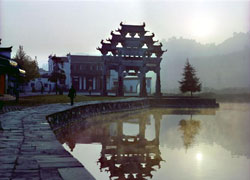Huangshan Xidi Village
 Xidi is a world cultural heritage site listed by UNESCO since 2000 together with the village of Hongcun. The village features century-old houses and architecture. Its residents have shunned any modern advancement all together and have lived the same way they lived centuries ago. These make Xidi Village a huge open-air museum.
Xidi is a world cultural heritage site listed by UNESCO since 2000 together with the village of Hongcun. The village features century-old houses and architecture. Its residents have shunned any modern advancement all together and have lived the same way they lived centuries ago. These make Xidi Village a huge open-air museum.
Its two main streets and 99 lanes are all paved with cobbles or black stones. Widely spaced commercial buildings, which are built alongside streams, are made from timber, brick walls, and are elegantly decorated using different sculptures.
Due to different various water courses flowing through the village, its original name was Xichuan which means West River. It was first built during the Huangyou era of the Song Dynasty Emperor Renzong.
The history of the village is closely tied to Hu family and their fortunes. They are the first people to put up businesses here that led to the construction of public infrastructure and major private buildings. By 17th century, the Hu family ventured into politics.
The major attractions of the village are the 124 well-preserved residences that were mostly made of wood. They were built from the Ming and Qing Dynasties. Many are open to the public. Other must-sees are Linyun Pavilion, Ruiyu Courtyard, Eastern and Western Gardens, Taoli Gardgen, Lvfu Hall, and Da Fu Grand House.
A Fairy Tale
Many visitors of Xidi Village have said that the place appears to be like a page in a fairy tale. In fact, it is known in China as “a village in the beautiful Chinese picture.” Using the word magnificent to describe it is an understatement. The village is embraced by mountains and it features streams, paddy fields, and several goldfish ponds. Sculptors, architects, industrial artists, planners, and painters looking for abundant sources of inspiration are often “regulars”.
Well-preserved Village
The residences, which are perfectly arranged, are all built using black tiles and pink walls. The most famous is the Chengzhi Hall, which was previously dubbed as the “folk imperial palace.” Other halls that are worth visiting are Xuren, Sanli, Dongxian, and Jinxiu.
Xidi’s town walls are surrounded by ancestral farmlands that are still tended by the original descendants. Travelers who visit the place will get the feeling of authentic and complete farming community.
Huge ancestral temples that date back from the Qing Dynasty dominate the center of the village. Reenactments showing the way of life of old residents are occasionally held by the tourism board in the temples.
Aside from buildings and ancient temples, the real attractions there are unpretentious local residences. These are passed down to family members for centuries. There is an unwritten rule that keeps the people from selling their ancestral property to outsiders. Because of this, the integrity of preserving the village ownership remains intact up to this day.
Useful Information
Address: Yixian County, Huangshan City
How to get there: From Qiyun Dadao, take a bus to Yixian at Tunxi New Bus Station. Get off at Yixian and catch a mini bus to Xidi (Fare: CNY2/person)
Admission: CNY 104/person



